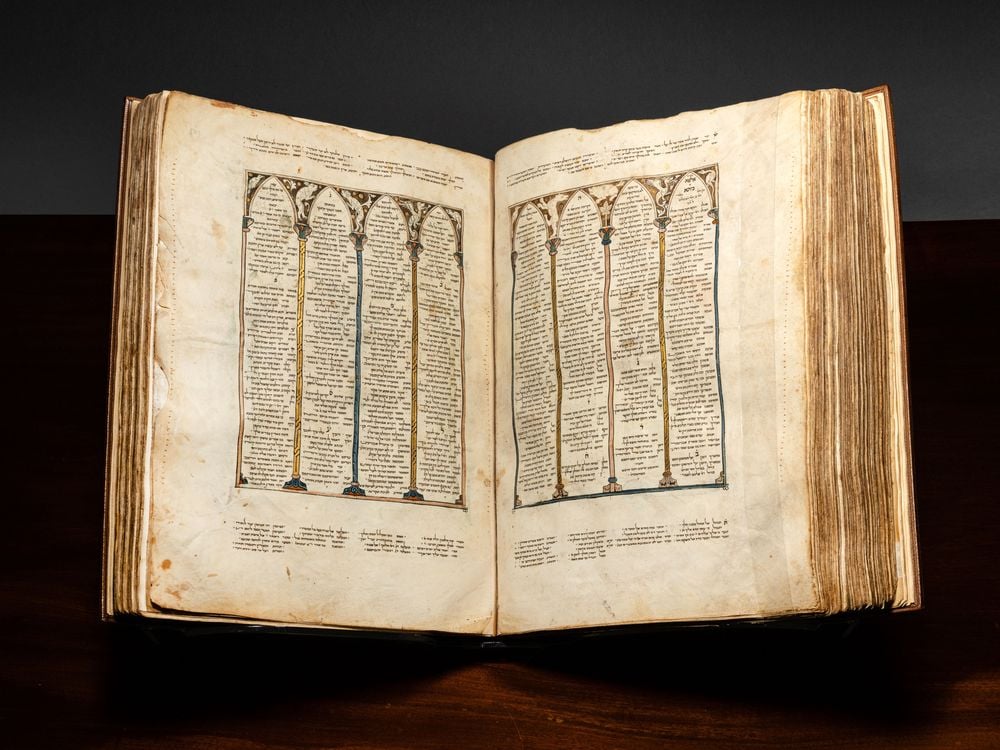Hebrew Bible From Medieval Spain Could Sell for $7 Million
After years of painstaking work, Rabbi Shem Tov Ibn Gaon finished the illustrated manuscript in 1312

A 700-year-old Hebrew Bible from medieval Spain is expected to sell for between $5 million and $7 million at auction next month.
The Shem Tov Bible is a 768-page illustrated text written on parchment in the early 14th century. It’s being sold by collector Jaqui Safra, who purchased it in a private sale in 1994. The last time it was available during a public auction was in 1984, when it sold for $825,000 to an anonymous collector.
“It’s such a wonderful masterpiece,” Sharon Liberman Mintz, Sotheby’s international senior specialist of Judaica, tells Penta’s Abby Schultz. “It’s rare to have illuminated Hebrew Bibles come to the market.”
“Illuminated” refers to the Bible’s gold and silver leaf decorations, as well as its colorful pigments.
The text was copied by Rabbi Shem Tov Ibn Gaon. Born in the 1270s or 1280s in Soria, a city in north-central Spain, the scholar of Jewish law and mysticism studied under some of the great rabbis of his day.
He spent an unknown number of years painstakingly working on the Shem Tov Bible, taking great care to make every letter and illustration as perfect as possible.
After finishing work on the Bible in 1312, he spent more than two years traveling and ultimately ended up in Israel. He visited Tiberias and Jerusalem before settling in the city of Safed, where he died around the year 1330.
Not long after his death, the Bible was acquired by Sar Shalom ben Phinehas, a Jewish leader in 14th-century Baghdad. Historians think it stayed in the Middle East for hundreds of years and may have been rebound.
The Bible resurfaced in Tunisia in 1868, when a prominent Jewish scholar named Eliezer Ashkenazi tried to buy it. However, the family that owned it decided against selling the text.
In the decades that followed, it ended up with a family in Libya, who sold it to the renowned Judaica collector David Solomon Sassoon in 1909. After the Sassoon family sold it in 1984, the Bible went on display as part of exhibitions in Amsterdam, Berlin, New York and Dallas throughout the 1990s.
Today, the manuscript is in “exceptionally fine condition,” according to a statement from Sotheby’s. It incorporates Jewish, Christian and Islamic artistic styles, including arches that look like they belong at the Alhambra (a Moorish palace in Spain) and traditional Jewish scribal flourishes in the margins, as Mintz tells Penta.
“It really melds together this wonderful moment when you had this golden age of Spain, and this manuscript embodies that,” she adds.
The manuscript is also valuable because it references the Hilleli Codex, a famous copy of the Hebrew Bible made in the seventh century. It was used as a model for many subsequent copies of the Hebrew Bible made between the 13th and 15th centuries, though it is now lost to history.
“The Shem Tov Bible is an essential piece of religious history that plays a critical part in the faithful, accurate transmission of the Hebrew Bible as we understand it today,” says Mintz, per Fine Books & Collections. “Its connection to the famed Codex Hilleli cannot be overstated, providing a critical bridge to this lost and mythic text.”

